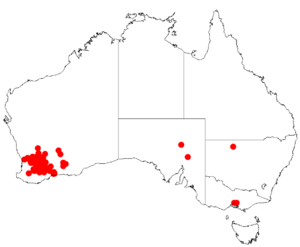Acacia leptopetala facts for kids
Quick facts for kids Acacia leptopetala |
|
|---|---|
| Scientific classification | |
| Genus: |
Acacia
|
| Species: |
leptopetala
|
 |
|
| Occurrence data from AVH | |
Acacia leptopetala is a type of shrub, which is a bushy plant, that belongs to the Acacia family. It's special because it only grows in a certain part of southwestern Australia. This makes it an endemic plant, meaning it's native and unique to that area.
What This Bush Looks Like
This Acacia bush is usually thick and has many stems. It typically grows to be about 1 to 3 meters (3 to 10 feet) tall. Its small branches are smooth and often have a fine white powder on them.
Like most Acacia plants, it doesn't have true leaves. Instead, it has special flattened stems called phyllodes. These phyllodes are thin but tough, and they have a blue-green color. They are shaped like narrow ovals and can sometimes be slightly curved. Each phyllode is usually 2 to 5.5 centimeters (0.8 to 2.2 inches) long and 3 to 11 millimeters (0.1 to 0.4 inches) wide. They also have a raised line down the middle. This plant produces pretty yellow flowers from November to January.
How it Got its Name
This plant was first officially described by a botanist named George Bentham in 1855. He wrote about it in a science paper called Plantae Muellerianae: Mimoseae.
Later, in 2003, another botanist named Leslie Pedley changed its name to Racosperma leptopetalum. But then, in 2006, it was moved back to the Acacia family, so its name became Acacia leptopetala again.
Where it Grows
Acacia leptopetala is found in several regions of Western Australia. These areas include the Great Southern, Wheatbelt, and Goldfields-Esperance regions.
It commonly grows on flat areas in different types of soil. You can find it from places like Bencubbin in the north, down to Nyabing in the southwest, and as far east as Ravensthorpe. It grows well in loamy, clay, sandy loam, sand, and sandy gravel soils, often as part of mallee scrub (a type of bushland).

